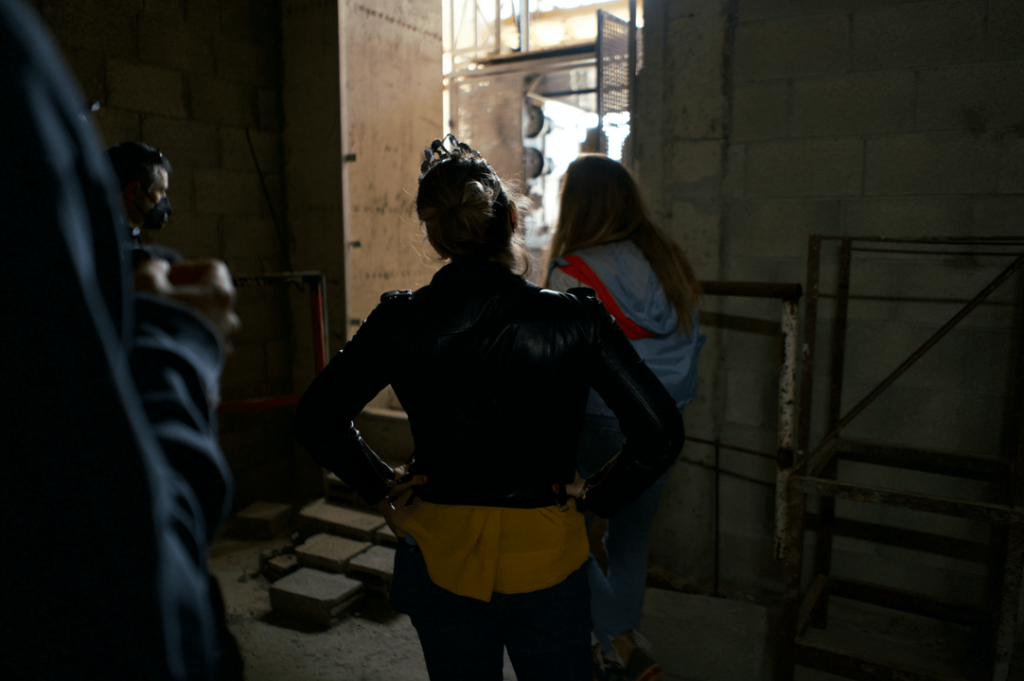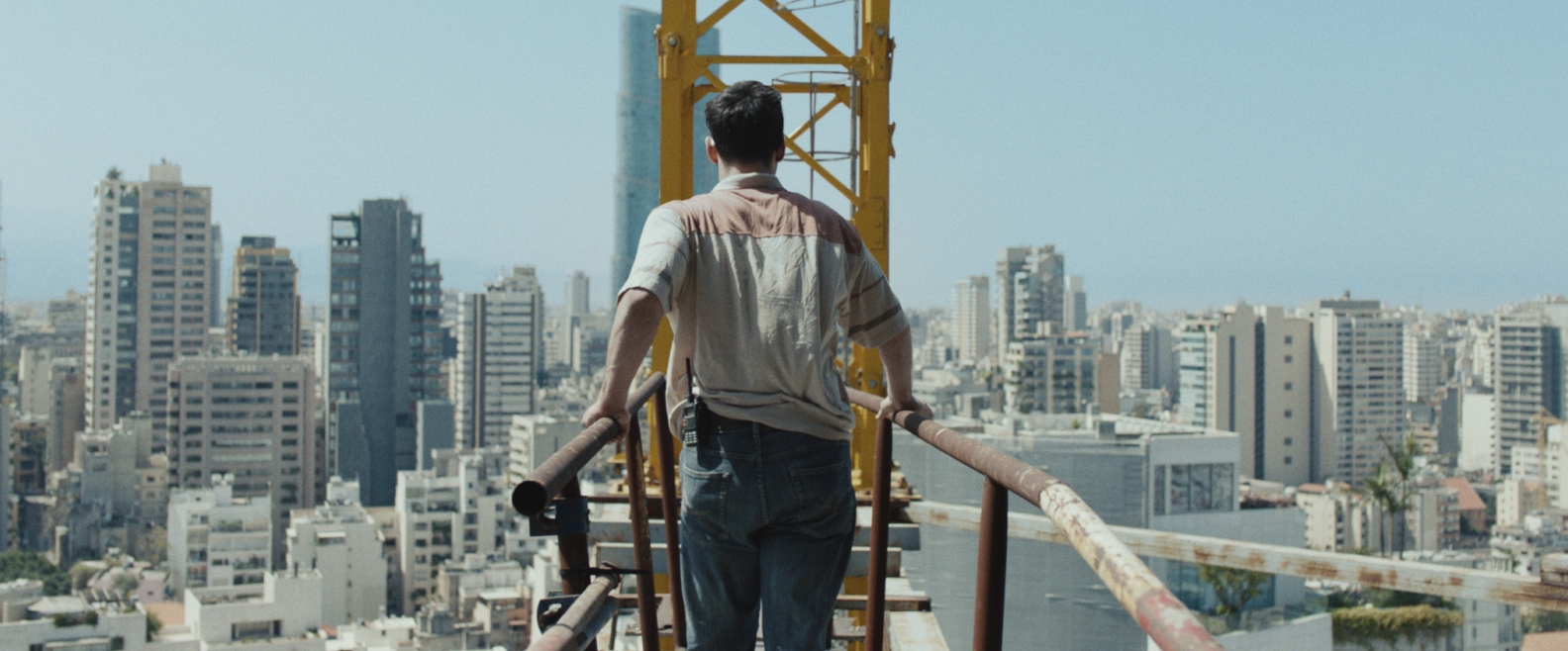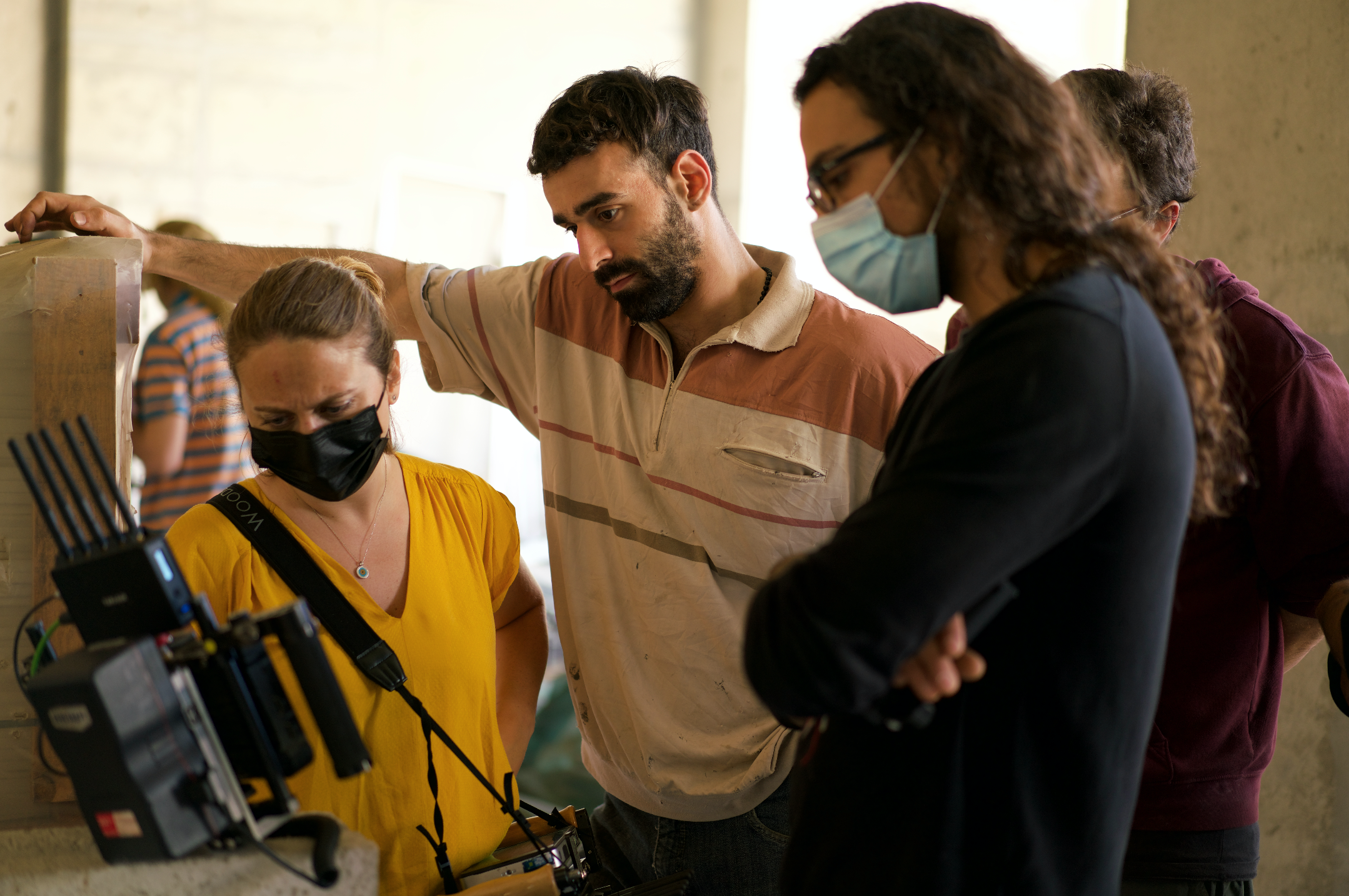Dania Bdeir: “Life is more liberating if we are able not to think in categories.”
Lebanese-Canadian writer and director Dania Bdeir received the Jury Prize for Best Fiction at Tampere Film Festival for Warsha.

With Tampere Film Festival taking place last week, we had the opportunity to talk to Lebanese-Canadian writer and director Dania Bdeir, who won the Jury Prize for Best Fiction at the festival for Warsha. The film had already gotten off to an impressive start at festivals: after premiering in Sundance and winning the Jury Prize for the Best International Short Film, it was selected to IFFR and Clermont-Ferrand. Our interview took place just shortly before Bdeir departed for another screening at SXSW. Bdeir is no stranger to a successful festival trajectory. Her previous shorts made during her film studies in NYU, In White (2016) and Kaleidoscope (2014) were screened altogether in more than 40 festivals worldwide and won various awards.
Warsha follows Mohammad, a Syrian crane operator portrayed by Lebanese artist Khansa, who volunteers to work at one of Beirut’s tallest and most dangerous cranes after an accident occurred. Once all alone at height, Mohammad becomes aware of an emancipating force. At Bdeir’s request, we aim to refrain from disclosing revealing details about significant plot developments.
Let’s start with the title. Where does it originate from?
It simply means “construction site”; it doesn’t really have a deep story behind it. It was kind of the first title that I thought of, and I just ran with it. But it does also mean something like “in construction” because part of the character’s journey is still “in construction” as well.
There’s definitely the idea of “shaping” and “molding.” What inspired you to make the film, and why were you interested in exploring those specific themes?
It all started in 2017. I was sitting on my balcony in Lebanon. At the time, Beirut had so many cranes. It was really like a city that’s always rebuilding itself, always giving itself facelifts and luxurious buildings. I saw one crane in particular where a man was standing on top of the cabin. He caught my attention because I was scared; I thought he was going to jump, or why else would he be up there? He kneeled down and put his forehead to the ground: I realised that he was praying. Such a beautiful sight, I just got mesmerised by it. I started being infatuated with the world of crane operators, as I realised that we see cranes around us all the time, but we rarely think about the little person in that cabin, who is operating this huge machinery, who can see the world, but nobody can see them.
I started visiting construction sites and talking to my engineer friends who brought me on to their sites for research. There were always very palpable elements that I noticed every time I was there. First of all, it’s a very masculine space: I was always the only woman there. Two, it’s a very loud space. You can hardly hear yourself thinking or dreaming, let alone have any ideas of your own, because of how aggressive the sound is. And thirdly, in Lebanon, workers are 99% Syrian, undocumented, and underpaid. It has been like this even before the war in Syria.

Warsha
So, there tends to be a very distinct hierarchy between the workers, the bosses, and the engineers. The workers tend to work collectively and don’t call too much individual attention to themselves; they try to be as invisible as possible. I really liked the idea that the crane operator is somebody who arrives with his colleagues in the morning but is the only one who gets to escape all of that. He gets on his ladder and leaves all of those things behind—the masculinity, the noise, the social hierarchy—, by climbing all the way up, rising above it, into that cocoon of his. That’s when I knew I was going to make a short film where the protagonist was a crane operator, but I didn’t have everything figured out yet. It was still cooking in my head.
Around that time, there was a new song released by singer and dancer Khansa. I fell in love with it and went to watch him live. His performance was outstanding and very transcendental. He would belly dance and Sufi dance and sing and move in ways that blended masculinity and femininity and kind of blur the lines of gender in a very seamless way. Throughout the show, I forgot what I was watching: Are they a man or a woman? It was just art, just beauty.
After the concert, we started talking and sharing ideas. I told him that I was working on Warsha and we started discussing. What the crane operator wants to seek up there is the space to unleash something, a desire burning inside of him, something he can’t really express in his daily life. The idea locked in as a story. It was an ambitious project that took about four years to finalise from start to finish.
How did you then develop the story and the journey of the main character?
When it became time to prepare for the shooting, Khansa and I worked a lot on the character development and how he was going to play that role. What would come from his own life, and what from other experiences? During the preparation, he went to work on a construction site himself for two or three days, and we didn’t tell anyone from the site that he was an actor. He just had to arrive with them in the morning and do the work all day. He brought back a lot from this experience as well. We based Mohamad on Khansa’s answers, his upbringing, and the feelings he knows so well—too well. Then bringing in things that are “distinctly Mohammad”: context from the construction site world and details of Syrian upbringing.
I can only imagine it was a highly complex production, shot in ambitious conditions. Yet, the film still feels realistic. Did you combine studio and on-set shooting?
At first, I wanted to shoot everything on location because I was looking for authenticity but my producer was telling me: “That’s crazy. We can’t.” And I was like: “I’m sure there’s a way.” In 2018, we went to shoot a teaser to help us with the fundraising campaign. Just me, the actor, and a camera operator. When it was time to go up to the cabin, the camera operator who had agreed to it beforehand, froze when he saw the ladder up close and looked up. “Listen, I have kids. I can’t do it.” So, he gave me the camera, and I climbed up the ladder. I’m someone who is quite comfortable with heights, but the second I grabbed the ladder, I got dizzy. It was something I couldn’t control; I had to just focus on holding the bars and putting one hand in front of the other. I realised that even if I just moved a little bit to the right, I have the risk of falling. That was the day I came back and called the producer and said: “I think you’re right; it’s not realistic. Let’s figure out something else.”
My producer, Coralie Dias, found a post-production company in France, La Planète Rouge. They were just in the process of building a new state-of-the-art virtual production studio, and the largest one in France that had floor-to-ceiling curved LED walls where instead of a green screen, you could input the footage that you need. The kind of technology they use in Marvel and Disney films. We were very lucky that they finished building it. We shot in Beirut for four days, and then everything above the ladder was shot in a studio. It was an incredible opportunity to work with this technology. I was blown away because I was very nervous before. How was I going to direct, sitting in a green room and imagining Beirut is at your feet? But we managed: we were in the south of France and in Lebanon at the same time.
Watching your previous films, Kaleidoscope and In White, I noticed a common thread of displacement and alienation that one feels from society. A certain tension between the accepted norms or traditions and the individual wish to break free, to be independent. In In White, there’s a clash of cultures between a conservative family and so-called modern values. In Warsha, we see an underlying conflict between societal norms and the individual’s identity. All of your films talk about taking action and holding responsibility. Do you recognise these themes and what do you think led to explore those?
Honestly, it’s only recently that I started noticing these patterns. It’s interesting. I don’t know if it’s necessarily because of growing up in a place like Lebanon, which is small and has a collectivist culture; the actions of an individual reflect back on their family, neighbourhood, and community. There is always the idea of interconnection, which makes people feel like they’re watching each other to a certain extent. Who’s stepping up above the line? Things seem to be binary: they are okay, or they are not okay.
When I was twenty-one, I moved to New York, which is quite the opposite. It’s one of the most liberated cities in the world, where there are no rules, and people go there to be whoever the hell they want to be. Nobody’s watching; you’re almost anonymous. People express themselves very, very freely. So definitely that’s why In White was partly about that. When I belonged to both those places, Lebanon and NYC, I could feel them clash. I didn’t even realise Warsha was going to revisit that.

Behind the scenes of Warsha © Mani Ferneini
Clearly, there’s something that I feel strongly about life being so much more freeing, liberating, and joyful if we are able not to have rules, categories, or limitations of how one should be or how one should behave. This idea of the city of Beirut in Warsha is of a chaotic and loud place. The only way for Mohammad to have some form of privacy is to go all the way up there where there’s nothing but clouds around. It’s completely in the open. I like to see what happens when you take your characters away from the box and let them just be.
About the music score in the film. You use a classic song, mixed in a new way.
The song is called “The Ruins”, and the performer is Umm Kulthum, an extremely iconic Egyptian singer from the seventies. We really wanted to work with that from the beginning because of the lyrics: “Unchain my hands, liberate me, give me my freedom”. It’s so powerful.
In order to make this remixed track, I worked with a Syrian music producer called Hello Psychaleppo. He invented this type of music and coined the term Electro Tarab. Tarab is the Arabic word for this classical way of singing. He uses beautiful, old classical songs and pushes them in a new direction. We worked together on how we could start from the original song and break into this kind of safe space, knowing well that this other place didn’t necessarily have to feel climactic because the act of liberation is not a simple one. It’s full of inner conflict: you have to fight your own self, your perceptions of yourself, your personal demons, and the opinions people might have. There’s not an easy way to release yourself from that. You have to go through the pain in order to reach the beauty. The music was very much about that, the story of the journey it takes.
What got you into filmmaking in the first place?
I’m the youngest of four girls, and my sisters are much older than me, so I didn’t really have anyone to play with when I was growing up. I used to watch a lot of television, mostly American sitcoms. I was very much a television child. I used to love acting and originally wanted to become an actress. When I was sixteen, my dad, may he rest in peace, gifted me a video camera and a mini DV, which was super new and expensive. My mother asked him: “Why are you gifting her something so expensive? She’s so young. She’s sixteen; she’s going to break it.” But I think he saw something in me and ever since I had the camera, it simply switched.
I became the person behind it. The person in the group of friends who was always filming and editing everything. That’s how I started loving the idea of storytelling. But when it was about time to go to university, I didn’t have the courage or the encouragement to actually go study film. My mom thought of it as a hobby and encouraged me to get into a job that would make me money. So I ended up going into graphic design, but I was a terrible graphic designer. The good thing about that: it’s a beautiful way to learn visual communication. The American University of Beirut, where I went, was very much rooted in the environment. The task was not just to “make a logo”; we had to “make a logo for a local shop in the street, answering to their needs.”
In those four years, I travelled all around Lebanon, interacting with so many different types of people, soaking up many stories, and realising that all of the content I was consuming on television was nothing like what was around me. I saw things in my culture that had beauty, ugliness, history, but also humour, complexity, religion… I felt this lack of representation and thought: “Who would be able to tell these stories if not me?” By then, I had already visited my sister in New York and visited NYU, and I knew that this was where I needed to be. Right when I graduated as a graphic designer, I got accepted to NYU and moved there to start an MFA in writing and directing.
Your recent short films, some made during your studies, were very successful on the international film festival circuit. Do you have any tips to share with young filmmakers about the distribution process? How have you managed to find an audience for your films?
For In White, I was submitting to festivals myself. You don’t realise how expensive and time-consuming the process is until you actually do it. I wish I had thought about that before. One advice would definitely be to put that in your budget from the beginning. Another advice would be not to be completely heartbroken if the film is not accepted. This was one of the best things I learned at film school. Because I had heard of other NYU filmmakers with a second-year film going to Sundance and other A-list festivals, I had put all this pressure on myself to do the same and felt heartbroken when the film wasn’t getting into the high-tier festivals.
But a professor had told me: “Every film is a preparation for your next one, don’t be too hard on yourself”. When In White started at Clermont Ferrand, which was great, I went there, and I just tried to talk to as many people as possible. I really tried to soak it up and be very, very present there. Actually, the only reason I found my producer for Warsha is because of Clermont Ferrand. The year after I showed In White there, they organised a pitching session for short films where you can meet different producers. That’s where I met mine.
In every chance you have, you have to go and network and meet filmmakers or industry people. At the end of the day, everyone there loves cinema. That’s what’s so nice about getting into a festival: being able to be in one place with all these people who are kind of geeky and passionate about the same thing, and you keep these connections for a long, long time.
